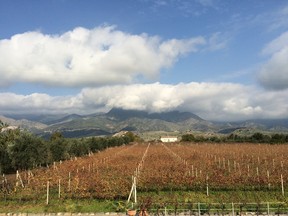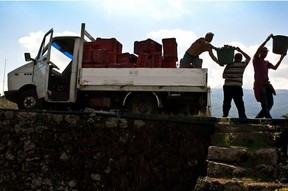Last: Sicily’s Mount Etna: where fire and wine meet

Article content
Reviews and recommendations are unbiased and products are independently selected. Postmedia may earn an affiliate commission from purchases made through links on this page.
Situated on the east coast of Sicily is Mount Etna, one of the world’s most active volcanoes. Over the centuries it’s estimated that 35,000 people have died from its destructive forces, although not all directly from the impact of lava flows. In modern times the body count is relatively low at 77, but there is no question that living in the shadow of such a destructive force of nature is fraught with risk. So why then would it seem like a good idea to invest in vineyards and winemaking ventures in such a precarious region?
For a start, the lava flows and activity are generally limited to specific areas around Etna, so the vineyards have generally been established in low-risk areas. Etna is tall enough – at 3,000 metres – that it gets snow in the winter, enough to support two ski resorts on the northern and southern slopes. During the winter months, the hot, dry, sirocco winds drift north from the Sahara Desert across the Mediterranean Sea, gathering moisture and dumping considerable amounts of snow on the peaks, providing a skiing experience unlike any other. The allure for winemakers is the fertile, volcanic soils that are frequently enhanced by the deposits of ash from eruptions. The predominant indigenous grape varietals include nerello mascalese, frappato, and nero d’avola for the reds, and for the whites, it’s mainly carricante, catarrato, and grillo. These grapes thrive in the volcanic soils, delivering wines that exhibit flavours and characteristics unique to the wine world.

Over the past couple of decades, there has been a shift to quality in the Etna DOC, and the wine world has noticed. The wines, particularly the reds made from nerello mascalese, have become sought after for their beguiling combination of elegance and power, not unlike a great pinot noir, for example. There is a core of red berry fruit, typically accompanied by some spice notes that include cinnamon and woodsy undertones, along with a subtle floral component. For the most part, the tannic structure is ripe and silky, although some of the top wines can show some grip, making them ideal for cellaring (Alta Mora’s Guardiola is a good example of this). The whites should not be overlooked either, particularly the ones made from catarrato. They can produce unctuous wines brimming with elements of lemon oil, minerals, and white flowers. If you’re bored with chardonnay, this is a great alternative, and in many ways offers a more layered and nuanced wine, with obvious exceptions in the pricey, high-end Burgundy realm.
On the surface, it would appear that Etna is a new DOC, but that’s really a factor of the wine world taking notice over the last decade or so. The Greeks were making wine on Etna as early as 8th century BC and it has remained a constant despite setbacks like phylloxera and volcanic activity. The DOC was established in 1968 and there is a push to elevate the best producers to DOCG (the top level of quality in Italian wines), and I would say that move is well-deserved. Some of the newer producers have discovered abandoned vineyards that just needed a little TLC to bring them back into production. Pietradolce, one of my favourites among the new guard, discovered a 90-year-old vineyard and did just that, producing a wine called Archineri made solely from those grapes, and it’s a beauty. Then you have producers like Salvo Foti (whose wines have just become available in Alberta), a man who consults for many of the region’s top producers in addition to making his own exceptional wines. I just had a bottle of his Aurora, a stunning white made from carricante that reminded me of a good Meursault, minus the oak.
Another favourite is Alta Mora, launched in 2013 by the Cusumano family. They have established vineyards in five distinct and highly regarded sites, some of which hit the 1,000 metre mark in elevation. Like many Etna producers, the wines are made with minimal intervention, allowing the terroir to speak for itself. Their cellar is carved into volcanic rock, which provides self-regulating temperature control while reducing their carbon footprint. Their whites and reds are top notch, and while not cheap at about $45 a bottle, they are worth every penny. Other top producers you can find in our market include Feudo Montoni, Gulpi, Tenuta delle Terre Nere, Massimo Lentsch, Tornatore, and I expect a few others I have not tried yet. You can expect to pay between $35 to $80 for the top wines from Etna, not cheap, but in my opinion, they are very well priced relative to the quality and personality they deliver. Cheers!
Geoff Last is a longtime Calgary wine merchant writer, instructor, and broadcaster. He can be heard every Friday on CJSW’s Road Pops program from 4 to 6 p.m. lastcallforwine@gmail.com












Postmedia is committed to maintaining a lively but civil forum for discussion. Please keep comments relevant and respectful. Comments may take up to an hour to appear on the site. You will receive an email if there is a reply to your comment, an update to a thread you follow or if a user you follow comments. Visit our Community Guidelines for more information.